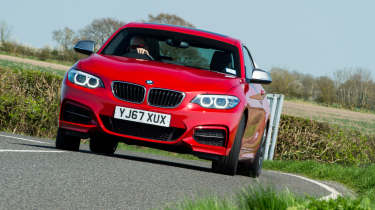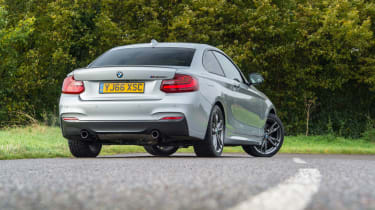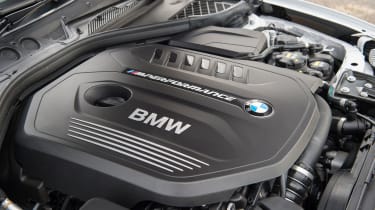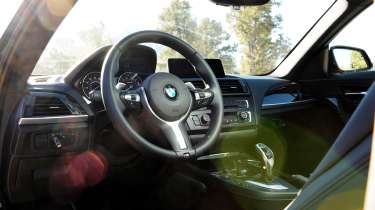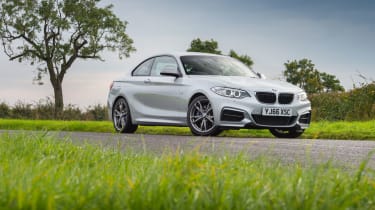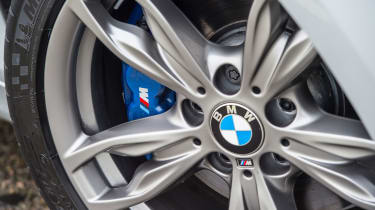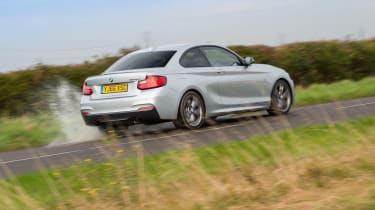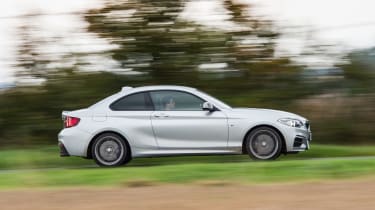Used BMW M235i and M240i Coupe (F22, 2014 - 2021): review and specs for BMW’s junior M car
The M2 is a great car, but the slightly less manic BMW M235i and M240i are the better allrounders
BMW’s 2-series moniker is one area of the Bavarian concern’s model line-up that’s been a little bit confused over the past decade or so. It’s a rear-drive coupe and convertible, a Mini-based front-wheel drive MPV with five or seven seats, another rear-drive coupe and a Mini-based four-door coupe. And, of course, the basis for two of our favourite M cars, the F87 and G87 M2s. In among that cornucopia of machinery there are some duffers and some greats and one of the most impressive is the F22 generation M235i and M240i. M car performance without M car running costs?
The M235i and M240i Coupes were high points in the BMW range back in the mid-2010s. They weren’t billed as a full M-cars – instead, they were part of BMW’s new M Performance range, which was intended to be a gateway between the high-performance cars and the standard models. Nonetheless, they were a compelling mix of dynamic ability, performance and affordability, with the styling to go with it. The chassis was agile and well balanced, with all the rear-wheel drive adjustability that you’d expect of a performance BMW. The turbocharged in-line six-cylinder engine was strong and responsive, while both gearbox options – six-speed manual and eight-speed torque converter auto – worked effectively and suited the car well.
More reviews
Group tests
- BMW M3 CS v Litchfield BMW M2: which makes the better track car?
- BMW 230i M Sport v Volkswagen Golf GTI Clubsport
In-depth reviews
Long term tests
Reviews
> BMW M2 2024 review – an M4 with attitude
The M-lite coupes also occupied a sector of the market where they didn’t really have a huge number of rivals. Dynamically the 981 Cayman was a superior machine but the standard 2.7-litre wasn’t as quick, while the Cayman S was considerably more expensive when similarly specced. The 718 Cayman again had the better chassis but the four-cylinder couldn’t hold a candle to the BMW’s straight-six. Neither Cayman was as practical. The Audi TTS had less power, was more expensive and was also less practical, too.
To go with the coupe there were also convertible versions of the M235i and M240i and while they were still rapid, they lacked the chassis rigidity that made the coupes such fun. The convertible still felt inherently well-balanced, so it worked both the front and rear axles equally hard through corners. Despite the extra weight it was still an agile and well-poised car, which could be persuaded to take up a little attitude under power at corner exit.
However, the problems arose when the driver pushed a little harder. Over bumpy roads it was actually possible to see the steering wheel and rear-view mirror shake and shimmy as the whole structure flexed. That loss of torsional rigidity gave the car a pervading sense of fragility, and it also meant that there just wasn’t the same precision and immediacy of response as in the coupe. The convertibles were still pleasant places to spend wheel time and the hood worked well, but just don’t expect the same level of involvement with the rag top.
BMW F22 M235i and M240i in detail
Revealed in 2013 the M235i went on sale in 2014 and was an immediate hit. Powered by the familiar N55 turbocharged 3-litre straight-six it developed 321bhp with 332lb ft of torque available from just 1300rpm. It was hooked up to a six-speed manual gearbox with an eight-speed ZF auto available as an option. Arriving on the options list after the car’s launch was an M Performance limited-slip differential.
While the M235i was no featherweight at 1455kg it still had 224bhp/ton so it was no surprise it was rapid, 0-62mph being dispatched in 5.0sec for the manual and 4.8sec for the auto. Top speed for both transmissions was 155mph. Despite this economy was quoted at 34.9mpg for the six-speed and 37.2 for the ZF auto, although those were under the old NEDC measuring system so can be taken with a large pinch of salt.
The chassis comprised typical BMW fare, MacPherson struts up front and a multi-link rear axle. M235i buyers had the choice of the standard fit M Sport suspension or adaptive M Sport suspension for £515 which gave the option of switching between softer and stiffer modes. The M235i also received an M Sport brake system with larger discs and four-piston front calipers and when BMW’s full range of M Performance accessories was launched there was a brake upgrade and 20mm lower suspension setup to choose from, too.
Externally the M235i could be distinguished from lesser 2-series M Sport models by its 18-inch double spoke alloys that weren’t offered for the rest of the range and by its grey mirror caps and grey airblades in place of the front fog lights. Xenon headlamps were a standard fit item, too. Standard colours were black or white, with metallic finishes costing an additional £550.
Inside it was obviously pretty much standard 2-series fare but the M235i did receive sports seats clad in leather, an M multi-function steering wheel and an interior comfort package. While all cars come with a 6.5-inch screen and iDrive when the M235i was launched BMW had yet to offer sat nav across the board so if this is a feature you want look at post-September 2015 cars or those that had it added as an option.
The latter part of 2016 saw the first major update to the model with the M235i being replaced by the M240i. At a glance there wasn’t a huge amount to write home about but the main change was a switch from the N55 engine to BMW’s then new modular unit, the B58. The new engine didn’t sound like it differed that much from the old one; both were described as using a turbocharged 3-litre straight-six. In fact, the new engine was slightly bigger with a swept capacity of 2998cc rather than the old engine’s 2979cc. The new engine’s single twin-scroll turbo was now fractionally larger too, helping increase power by 14bhp to 335bhp. Torque was significantly increased from 332lb ft to 369lb ft which made the M240i 0.2sec faster to 62mph no matter which transmission was optioned.
Mid-2017 saw the 2-series receive its mid-life facelift but there weren’t a huge number of updates for the M240i as it had already received its new engine the year before. There was a little tinkering with the car’s exterior with new LED headlights and redesigned LED rear lamp units, too. Inside there was a new dash and tweaks to the minor controls but there really weren’t any earthshattering changes that make the facelift car a must buy over the earlier cars.
What we said
‘On track, the 235i is noticeably flatter [than the M135i hatch] both into and through the corner. With 15 per cent stiffer springs and firmer bumps stops, this is to be expected, but the M235i feels lower and smaller too. Turn in too aggressively and your only reward will be the front tyres letting go and the nose running wide of the apex. But take a more considered approach, learn where the grip levels lie, and you find a beautifully balanced car that is very rewarding to string a lap together in.
‘The newly recalibrated DSC will let you have much bigger slides, too, and when it does rein everything back it does so much more smoothly, so you feel much happier leaving it on. If you turn it all off then there is of course the potential for even more fun. With the standard rear axle set-up, the only help comes from something called Active Differential Brake, a sort of pseudo LSD that brakes a spinning driven wheel under acceleration. Although ABD doesn’t give you the satisfying control of a proper LSD (a proper LSD is available as an option), the M235i is still a huge amount of fun over the limit.’ – Dan Prosser, M235i, 2014
‘The new engine is a real joy to rev right to its 7000rpm rev limit; it doesn’t lose any energy as it gets close to the red line and it continues to emit a distinctly six-cylinder timbre. Sadly, it sounds best from the outside.
‘The standard gearbox is a six-speed manual, and it really suits the torquey nature of the new engine; there’s impressive acceleration, even in the higher gears. The gear change isn’t the slickest of actions; it feels too rubbery and the centre armrest puts your arm at an awkward angle. However, there’s a much greater connection to the drivetrain with the manual gearbox than with the optional automatic.
‘The eight-speed torque-converter auto is the same ZF gearbox as in the old car and in, well, almost everything. How this transmission behaves in different cars can be quite dramatic, but it’s rarely as faultless as it in the BMW; it’s so incredibly easy to adapt to while also effecting quick, direct changes. It can be a bit too abrupt though, and in the wet the severe changes can cause the rear tyres to lose traction.’ – Will Beaumont, M240i, 2016
What to pay and buying guide
There are plenty of cars to choose from, but M240is are more plentiful thanks to their longer on-sale time. Both models are great buys, but it pays to do some homework before you take the plunge. Prices range from around £7500 for an early M235i with high miles to £25k for a late low mileage M240i.
Before buying there are several decisions to be made. Manual or automatic? N55 of B58 engine? Standard or modified? If you’re after a six-speed your ideal car could take a while to find as the ZF eight-speed auto was a far more popular choice among buyers. The M235i’s N55 has a slightly poorer reputation for reliability, but with many of these things the problems that do exists tend to be blown out of proportion on the internet.
Whether to buy a standard or modified example is a tricky conundrum. Both engines are tuneable so there are plenty of higher power examples to choose from, but do you really need it to be any faster than the standard car? They’re very quick straight out of the box. Perhaps better to search out one that’s had suspension upgrades or that have the LSD as these do make a difference to the way they can cope with the power. We’d advise against examples with 19-inch rims as they don’t do the ride any favours.
BMWs are generally fairly well screwed together so interiors should still be fine and shouldn’t have too many creaks and rattles. Electrical glitches with the iDrive are relatively common and can often be cured by a software update and there is a known fault with 2-series rear light clusters, too. Externally do the usual checks for paint issues such as different shades between panels or excessive stone chipping and examine the 18-inch wheels for damage.
The N55 engine in the M235i has a number of potential issues. Look for splits in the charge pipe connecting to the intercooler and throttle body and watch for valve cover oil leaks. Water pumps are a known weak point; they’re electric and expensive. High pressure fuel pump failures were common on older N55s but the M235i isn’t as badly affected as the older 335i was. Vanos variable valve timing solenoids can fail and the engine can suffer from carbon build up in the inlet manifold. The latter is a relatively simple fix via walnut blasting.
The B58 fitted to the M240i does seem to be garnering a better reputation than the N55 but still has a few problems. As with the N55 it’s susceptible to valve cover oil leaks and Vanos solenoid failures. It can also experience mysterious coolant leaks – often down to the tank cap – and has issues with PCV valve for the crank ventilation set up. Some owners have also experienced faulty fuel injectors.
With both engines check for a solid service history, regular oil changes being the key to longevity. As both units are turbocharged watch for signs of excessive smoke from the exhaust and make sure the engine runs smoothly and pulls as you’d expect it to when accelerating.
BMW M235i and M240i specs
| M235i | M240i | |
| Engine | In-line 6-cyl, 2979cc, turbocharged | In-line 6-cyl, 2979cc, turbocharged |
| Power | 321bhp | 335bhp |
| Torque | 331lb ft | 369lb ft |
| Weight | 1455kg (224bhp/ton) | 1470kg (232bhp/ton) |
| 0-62mph | 5sec | 4.8sec |
| Top speed | 155mph | 155mph |
| Price (new) | £34,250 (2014) | £36,415 (2017) |
